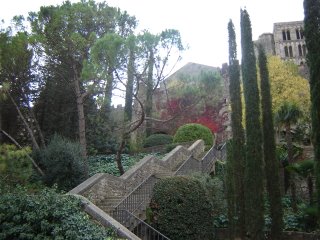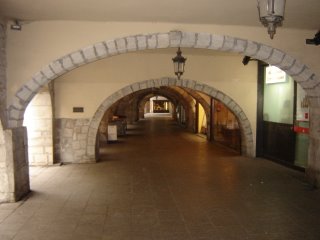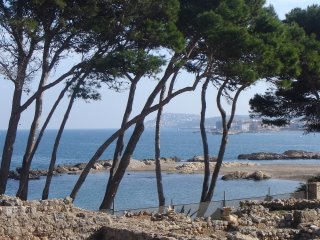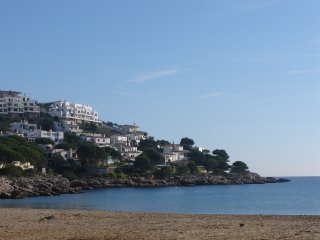Saturday, November 25, 2006
Girona, Spain
On the drive back from L'Escala,(see previous post) we stopped in Girona to do a little sightseeing. Girona is the provincial capital of, you guessed it, the province of Girona in northeast Spain. It lies at the confluence of the Ter and Onyar rivers. Through the years, this city has been ruled by the Iberians, Romans, Visigoths, Moors and Christians. A strong Jewish community developed for about four centuries until they were expelled by the Catholic Kings in 1492. Oh, those wacky Catholic Kings, nothing like a good Inquisition now and then to get the juices flowing.(Yes, the previous comment was sarcastic in nature, so, please, no nasty emails.) To the north of the old city is Montjuïc, which means "hill of the Jews" in Catalan. This city has one of the best preserved Jewish ghettos in Europe.
After a cafe con leche at a streetside cafe on a chilly, Autumn day, we walked around the cathedral area. Standard set up with narrow, winding streets with the cathedral being the centerpiece.
Tuesday, November 21, 2006
L'Escala, Spain
Last Saturday, Matt, I and 3 friends rented a car and drove northeast of Barcelona to Costa Brava for a weekend getaway. We stayed in a nice campground in the coastal city of L'Escala. The campground, nestled in a coastal pine grove, was nearly empty and very quiet. The days were mild and sunny and the nights were chilly. The first night, we stayed in a modular bungalow. The second night, we stayed in an A-frame type cabin. Both places had resident cat families in the area that we befriended by feeding them, of course.
Outside of town, on a hillside overlooking one of the bays, were the ruins of both Greek and Roman settlements. The Greek settlement, there from the 2nd century B.C. thru the first century B.C., consisted of the remains of the foundations of homes and the remains of the common area, called the Agora. Further up the hill, above the Greek ruins, were the ruins of the Roman settlement that was there from the first century B.C. through the first century A.D. It also consisted of the foundational remains of homes and their common area, called the Forum.
Speaking of rental cars, this was my first experience of driving in Europe. The car we had was very small. If you've ever seen those cartoons where 7 or 8 clowns pile out of a tiny car, that's how I felt. I know a car is too small when I have my foot on the gas pedal and the left edge of my foot can touch the break pedal. Not cool. Anyways, it took a while to get used to the rules of the road and the traffic circles, but no one was injured and no blood was drawn.
It was nice to get out the metropolis that is Barcelona, see the countryside and hang out in a small, quiet town.
Thursday, November 09, 2006
Barcelona, Spain - La Sagrada Familia
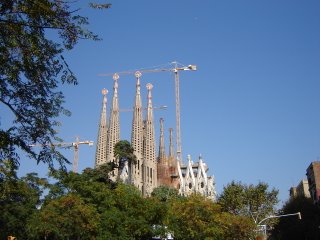
In my previous post, I introduced you to the Modernist architecture style of Antoni Gaudí. The last 15 years of his life were spent working on his masterpiece, La Sagrada Familia. (The Holy Family) It's a Catholic basilica in central Barcelona. Construction was slowed by both Gaudí's death in 1926 - he was run over by a tram - and by the Spanish Civil War, which began in 1935. From what I can see, there is a lot left to be done. In any event, the structure is massive and pictures don't do it justice. Although, it does help to enlarge the pictures by clicking on them. Also, please check out the following Wikipedia link for more information.
http://en.wikipedia.org/wiki/La_Sagrada_Familia
The Nativity Facade


The Passion Facade (my favorite)
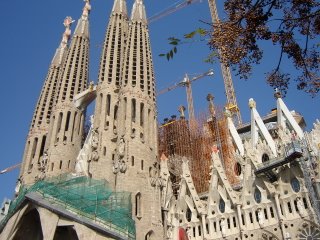




The North Facade



Wednesday, November 01, 2006
Barcelona, Spain - Antoni Gaudí
Antoni Gaudí (1852-1926) was a Spanish architect famous for his Art Nouveau, or Modernist, style. He deviated from traditional design by incorporating flowing, natural angles into his buildings. Barcelona is filled with many buildings of his design. Below, I have 3 examples of Modernist style. The first two by Gaudí and the third by Lluís Doménech. Gaudí's unfinished masterpiece, La Sagrada Familia, will be dealt with in a later post. It's unfinished because, during construction, he was run over by a tram and died two days later. Here is a better description of his work, which I found on the web...
Gaudi's work was greatly influenced by forms of nature and this is reflected by the use of curved construction stones, twisted iron sculptures, and organic-like forms which are traits of Gaudi's Barcelona architecture.
Gaudi also adorned many of his buildings with coloured tiles arranged in mosaic patterns. This added another important dimension to his buildings which is so often overlooked by architects - the use of colour.
Casa Batllo


Casa Milá

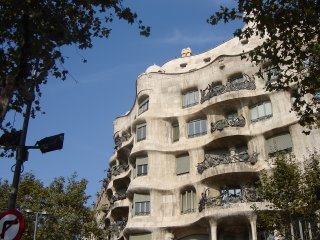
Palau de la Música Catalana
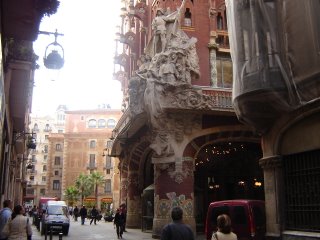
Gaudi's work was greatly influenced by forms of nature and this is reflected by the use of curved construction stones, twisted iron sculptures, and organic-like forms which are traits of Gaudi's Barcelona architecture.
Gaudi also adorned many of his buildings with coloured tiles arranged in mosaic patterns. This added another important dimension to his buildings which is so often overlooked by architects - the use of colour.
Casa Batllo


Casa Milá


Palau de la Música Catalana

Subscribe to:
Posts (Atom)










